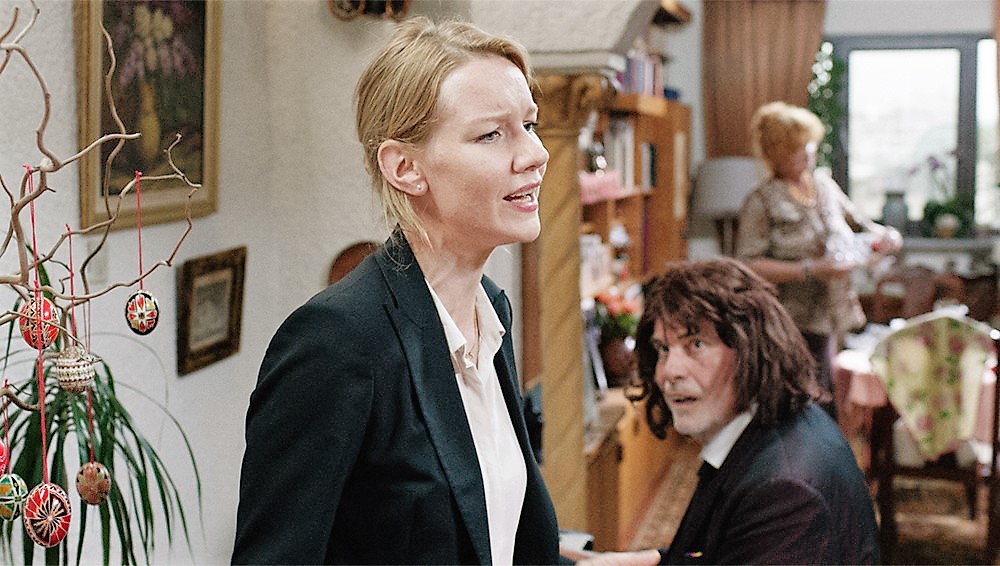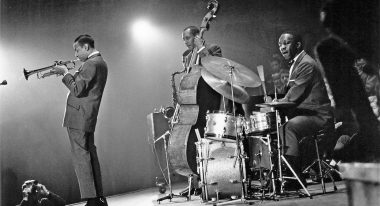
True Crit
Weekly film reviews. by Howard Feinstein
Studio 54: The New York Film Festival, Part I

 Sandra Hüller and Peter Simonischek in Toni Erdmann
Sandra Hüller and Peter Simonischek in Toni Erdmann On the evidence of the finest films in the first third of this 54th edition of the New York Film Festival, those familiar with the exhibitionistic, amped-up social set that frolicked in, gawked at, or read about the notorious, dear-departed Manhattan night spot might find it ironic, or a misnomer, that its moniker is my appropriated title for this initial NYFF feature. Sure, Lincoln Center ranks far lower on the cool scale than the legendary club, but, a testament to tenacity, merit, and resilience — how it has managed to survive continuous power struggles and administrative shuffles of parent organization Film Society of Lincoln Center is a question only a board member can answer — this monarch of New York cinema showcases just keeps on keeping on.
Admission to the fest, either as committee-selected directors at the top of their game or paying audience members sometimes motivated by the privilege of seeing a film only a few weeks before it opens commercially and plays to the rabble in a plex, is as coveted as the ritualistic parting of the red velvet ropes by a beefy bouncer outside Warhol and Bianca’s old haunt. The scene at 54 was rowdy, the habitues gregarious, even if in a self-absorbed, coked-up manner. Touchy feely.
These movies are at the opposite end of the spectrum. They are exemplars of extreme loneliness, in which the protagonists desperately search for, even create, companions to soothe the ache of solitude. The resulting attachments range from near-abstractions to tangible characters: figments of fertile imaginations (Neruda, A Quiet Passion, Moonlight) or their materialized embodiment (Toni Erdmann); or flesh-and-blood people who, unconsciously or not, colonize their present (I Called Him Morgan, Certain Women). Not surprisingly, in a group of films that leans toward the melancholic, death makes itself known, a hovering threat at its least toxic.
These films are each of a piece: unique, inventively designed but never so much as to be predictable. The array runs the gamut between naturalism and artifice. Many are hybrids, blending the extremes into polygenres, an approach that has become fashionable and gratuitous but here is appropriately temperate. Others are purer, less diffuse works, playing off generic conventions and expectations. Maren Ade describes the aesthetic of her Toni Erdmann as heightened realism: The principal character’s eccentric father dons fake wig and teeth to enact an alternate persona without leaping into the fantastic.
Moving in that direction, however, are Barry Jenkins’s Moonlight and Terence Davies’s A Quiet Passion, in which a few scenes in these otherwise naturalistic films are dreams or hallucinations bracketed to honor an unwritten contract between filmmaker and spectator designating boundaries. No blurring of real and unreal here. Pablo Larrain’s Neruda, however, is a full-on exercise in intentionally exaggerated artifice, visually and thematically. Forget linearity. The line between real and imaginary characters is unclear. Fiction becomes the subject of a film which is so meta that deconstructing it would be like trying to make sense of Russian dolls while walking through a maze.
A few quibbles, especially in a fine festival that has a few missed opportunities. There are a total of 82 features; twenty-five are in the Main Slate. (I wrote about this last year.) Most of these have distribution, many opening immediately after playing the fest. It includes a lot of the greatest hits; you get the feeling that most are curated through the prism of another curator, like what showed at Cannes, Sundance, and the other usual sources most programmers depend on. But where are the discoveries, the films you stumble upon at out-of-the-way fests, or during serendipitous encounters?
Below I note the films I am drawn to in this first batch that are not in the Main Slate, but in the secondary sidebars, like Spotlight on Documentary (15 features), Explorations (six), and Special Events (six). For me, all outside the Main Slate appear diminished (fewer screenings, fewer seats, no Alice Tully Hall, even smaller graphics on the website than the dominating Main Slate box — signifiers of loser!)
Seriously, such details are not insignificant. They scream “wait list” or “not quite accepted.” This placement denigrates films. If the Main Slate were competitive, I would get it. But it’s not, and none of the others are. And some titles slip into the Main Slate — a few docs, for example — from sidebars. What the hell is Explorations? Afterthoughts? Also-rans? One of the top two or three films is in that section (The Ornithologist). Terence Davies’s wonderful A Quiet Passion is in the sexy sounding “Film Comment Presents,” part of Special Events, and shows only one time, and only in the Walter Reade. Lotta confidence in ticket sales for that one! Self-fulfilling prophecy. Get out there and find audiences.
I almost succumbed to ignoring Davies’s film because of such a limited possibility for ticket purchase. In the world of journalism, hyping such an event is not considered reader friendly. Besides, for ease of scheduling, and often under editorial pressure, most journos cover the Main Slate, and maybe some of the Special Events. I caught myself: I decided to just go for quality. If I had followed my first line of thinking, I’d be as culpable as the schedulers. I confess.
Two more NYFF review features follow over the next 17 days, timed to their public NYFF screenings. The titles evaluated below, listed in no particular order, are, in my opinion, the very best films playing during the first week. I’ll write more at length about several at time of release.


I Called Him Morgan (Kasper Collin, Sweden)
SPOTLIGHT ON DOCUMENTARY
Swedish docmaker Collin directs this brilliant, melancholy, and soulful doc built around the relationship between hard-bop jazz genius Lee Morgan and his common-law wife, Helen. Taped interviews with each 25 years apart anchor the film, which recounts the intense melodrama of their lives separate and together, including persona reconstruction that defies credibility. Recordings of Lee’s music run throughout, accompanied by filmed interviews with his old pals and band mates and pristine black-and-white photographs maintained over the years by his label, Blue Note Records.
A prodigy, city-mouse Lee played clubs in Harlem for such biggies as Dizzy Gillespie and Art Blakey while still in his teens until he tossed his name and success in pursuit of heroin, the jazz man’s poison. Helen was a rural gal, a mother twice at 14, an outsider who went to New York and reinvented herself as a sexy talker and maternal aficionado of jazz musicians. It was almost inevitable that this lonely but sociable woman would pick this man 14 years her junior up off the floor and remake him as the easygoing talent he had been, even as his music took a strongly political turn.
Nurse, muse, and lover, she guided and accompanied him until a romantic betrayal undermined the strong ego she had so carefully carved out for herself. She broke and shot him in a jazz club, an ambulance stuck in a snowstorm providing a tragic final note while he bled to an avoidable death at the age of 33. She turned to religion and good works following a term in prison, maintaining her chameleon-like knack for transformation until her own demise 24 years later.


A Quiet Passion (Terence Davies, UK/Belgium)
SPECIAL EVENTS: FILM COMMENT PRESENTS
Another tortured artist is at the center of British filmmaker Davies’s narrative about the irresolvable conflicts endured by the American poet Emily Dickinson, played to subtle perfection by Cynthia Nixon. He layers the work, adding to the abundant dialogue between Emily and family friends and the family she lived with until her death, especially her beloved sister Vinnie (Jennifer Ehle), several of her poems in voiceover, readings from her abundant correspondence, and such storied period music as Charles Ives’s “The Unanswered Question.”
Davies creates a three-act trajectory, beginning with a nearly two-dimensional setting up of her comfortable life and the earliest signs of rebellion, then moving into a period of oscillation between conventional living and probing the dark recesses of her mind, and finally landing upon a near-total introversion, a period of severe illness but increased literary productivity.
The conflicts were internal in more than one sense. They all took place inside the Dickinson home, since she almost never ventured outdoors; and they were enacted inside her mind, because she was so uncompromisingly private. She wrote at night, shared her work with no one. She was only recognized posthumously, after Vinnie discovered 1800 unpublished poems. This was her dilemma: She wanted to be published, to be accepted, but she also desired independence. She refused to recognize that that requires giving up something of yourself. Even the attentions of a handsome gentleman took on a metaphysical form, a phantom-like force that signaled for her the threat of carnal relations in her life. Death and abandonment stalked her mercilessly. In the film, she even narrates her own funeral.
At the same time, the ordinary objects Davies and DP Florian Hoffmeister film inside the house assume an ethereal presence. In fact, the quotidian has enormous power in her writing; it reflects her extreme highs and lows. Her strong personal investment in her own self did not prevent her from taking to heart such controversial ethical issues of the time as slavery and women’s rights.


Neruda (Pablo Larraín, Chile/Argentina/France/Spain)
Chilean filmmaker Larraín never fails to surprise, deploying such appropriate strategies to make his very different works (Tony Manero, The Club) that they threaten to take on a life of their own. In fact, they sometimes do, as is the case with Neruda. Yet that state is a sensuous one, a mannered, baroque style of dreamlike artifice in which the camera rarely stops pacing and the editing steers clear of linearity. More to the point, it nearly revises the thinking about what a literary film can be, the limits to which one can go to define the relationship between author and fiction. It is also just right for a man well-known for his wandering, outside and in.
The story is too specific to Chile, in the late 1940s, to just be labelled Brechtian. This is when the great Communist poet of the quotidian, Pablo Neruda, later to win the Nobel Prize, is hunted by a government police inspector, Oscar Peluchonneau (Gael Garcia Bernal, playing the part as an endearing dandy, more likable than Luis Gnecco’s bourgeois, self-absorbed hedonist of a Neruda), in order to bring him in for impeachment as a senator. Treachery is endemic in this milieu.
The conceit here is that Peluchonneau is as enamored of Neruda as he is convinced of his threat, and taking it to a more theoretical, self-reflexive level, Larraín makes the detective a construct from the poet’s work. After we first hear the policeman’s voiceover, he introduces himself on camera as its source; he is merely a secondary character longing to be a principal. (The best performances come from the supporting actors who play the overwhelmed trannie who dances with his idol and the to-the-point, poverty-stricken washerwoman who confronts him about his class preference.) Prankster Neruda makes a game out of the dangerous thriller not by sending his poems to this admirer with a man-crush, but by delivering the books themselves in clever but daring, rather insensitive ways (in the coat pocket of a destitute Indian girl he has charitably hugged on the street, for example, setting up a false expectation for the baffled lawman); the intangible becomes tangible.
Toni Erdmann (Maren Ade, Germany)
This is an inspired oedipal film — a drama with funny moments, according to director Ade, that maintains momentum via fairly broad humor and the depiction of well-researched details about the new imperialistic capitalism connecting wealthy Germany to struggling Eastern Europe, an extended episode of Survivor! in which all rules are bent.
Wilfried Conradi (Peter Simonischek) is a divorced, retired piano teacher, a member of the postwar German social order that reacted to its immediate predecessors with a certain humanistic idealism about the following generation. After his old dog dies, he ventures to Bucharest to check out and perhaps forge a closer relationship with his thirtysomething only daughter, Ines (Sandra Hüller), who, a tightly wound corporate efficiency consultant, has so outgrown her use for him that she is contemptuous of all that he and his “green” generation stand for. He is mortified by the insensitive manner in which she treats the locals, but at the same time is put off by her shameless kowtowing to a nebbish corporate honcho whose business her team is desperately trying to wrangle.
He wants to show her the error of her ways, so stages an ongoing intervention. A man whose claim to fame is his ease with corny jokes, Conradi reinvents himself as Toni Erdmann. He begins to stalk her wearing a fright wig and large yellowed false teeth, passing himself off as the big cheese’s life coach, a particularly German occupation in vogue these days. Ultimately, she finds his alternate persona suitable for her professional purposes, because, she claims, women are not taken seriously in the German business world: Designating him as a colleague gives her wiggle room for maneuvers, especially while this domineering, fast-talking opportunist runs circles around clueless Romanian clients. She ends up appropriating the Freudian concept of the father that her own dad makes palpable by fancifully milking the unique capability of parents to infiltrate their offsprings’ unconscious. No longer embarrassed by his presence, she caves and internalizes him. Victory in defeat.


Moonlight (Barry Jenkins, US)
The final two films reviewed here are both triptychs, each section with a different actor in the lead. In Moonlight, however, all three portray the same character at different ages: 9, 16, and 25. The device is nothing new, but each is so right for the part that the solution seems valid.
Maleness in the black community, as well as the cruelty of the poverty cycle, is astutely observed through a very particular story driven by a restless camera, powerful music, and flawed participants affectionately drawn and fully recognizable. It was originally a theater piece by Tarell Alvin McCraney focusing on a young, bullied gay black fellow in Miami’s harsh Liberty City area of housing projects. He and director Jenkins grew up there: There’s a rare authenticity to every element, from characterizations to strangely seductive brightly painted buildings dwarfed by the large open spaces to the nasty intimidation of the physically weak by the stronger guys who’ve sadly adjusted well to the value system in place. Twisted Social Darwinism.
Drugs are a staple, and aid in dissolving traditional family structures. Jenkins captures the troubling scenes with graceful Steadicam shots, and overlays a soundtrack by Nicholas Britell heavy on the southern hip-hop style known as “Chopped and Screwed.” Britell bent the audio on his compositions, frequently slowing them down, and with it their pitch; then he added bursts of classical compositions.
We experience the transformation of an extremely quiet, easily intimidated boy named Chiron but nicknamed Little (Alex Hibbert), whose single mother is rapidly turning from volatile, non-coping nurse (a startling Naomie Harris) into full-time crack addict, from picked-on child in search of a father figure (drug dealer Juan, played by Mahershala Ali, is the first of the habitually stereotyped bad influences to warmly intervene for the good of the boy), to confused teen (Ashton Sanders), whose merciless bullying assumes a homophobic edge.
Following his formative male sexual experience with school chum Kevin (Jharrel Jerome), a warm womanizer to whom Chiron is in thrall (he has a dream featuring his buns), a whupping that cracks his defenses as well as his bones precipitates a violent act that lands him in prison, where he, like several of the protagonists in this group of films, recasts himself. It’s not for the good: He becomes an Atlanta-based, pumped-up drug dealer, a poseur who calls himself Black.
An out-of-the-blue phone call from Kevin, now a cook in Miami and, as it turns out, still something of a moral compass, reignites the fire between them after all these years, triggered by a rendition of their old song, Barbara Lewis’s hauntingly sad romance, “Hello Stranger”; the ending is left open. What is most impressive is how Jenkins makes credible wimpy Chiron’s rebirth as musclebound, do-ragged stud muffin Black so thought out that it seems a divine plan was in place to transform him into a young man who both he and old-flame Kevin could productively regroom — and accept.


Certain Women (Kelly Reichardt, US)
With a dream cast including Laura Dern, Michelle Williams, Kristen Stewart, and newcomer Lily Gladstone, Reichardt pins her hopes on three, technically four, actors, portraying different characters — all females — in a small, Last-Picture-Showish Montana town. They have little else in common, save that they are the focus of short stories by Montana-based author Maile Meloy; and they command the screen at key moments, even when they are not in control of the overall narrative.
The filmmaker does her own editing, softly abutting the gorgeous 16mm images shot by Christopher Blauvelt to help define these women and their places (or lack of) in a microcosm of the wider order — the opposite of the style of, say, Paul Haggis in Crash. Plot developments become part of a chain of democratic connections, rather than fresh events supplanting those that many wrongly consider exhausted. Forward momentum is a product of her clippy manner of cutting, in which a shot ends in media res or at some other moment when it is not expected. It’s never rushed. The technique works for the multiple scenes, often repeated, of redundant rural life—what are their options?–poignant, respectful observations of the details of a daily grind, the distinctiveness of the demographic (Native Americans are a major presence), and the contradictions that envelop decent, hard-working people who never learned how to work the system, and carry soul-crushing manifestations of anger, frustration, and bitterness to prove it.
The men are the defeated here, whether it’s cued by a violent action or by turning away from gut-wrenching emotional intrusions; James LeGros, Jared Harris, and the legendary Rene Auberjonois take on these trying roles. Without PC didacticism and precisely calculated options, Reichardt enables the women to meet head-on testy ordeals in which they are immersed but are nevertheless able to closely observe, for their own sakes and, it might be hoped, for the benefit of their sisters.
